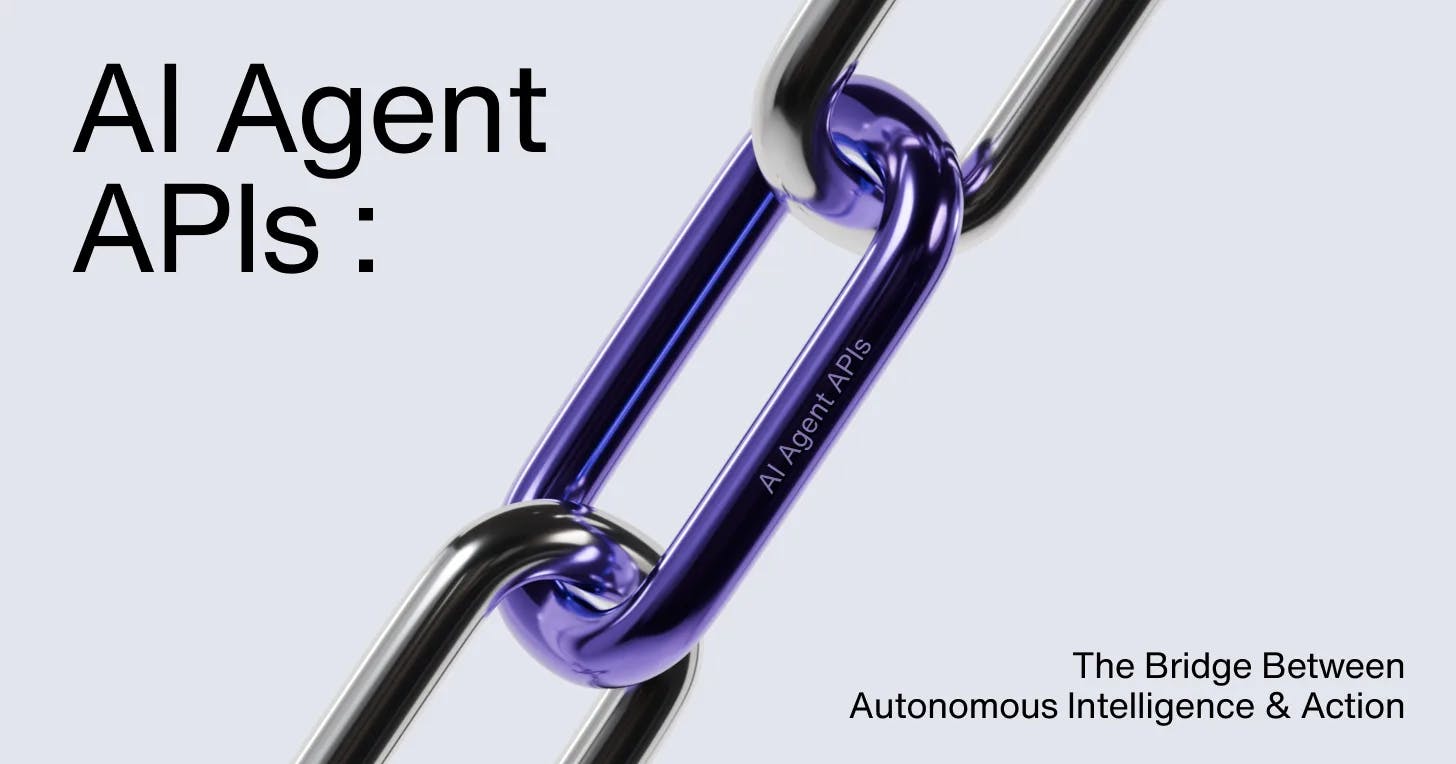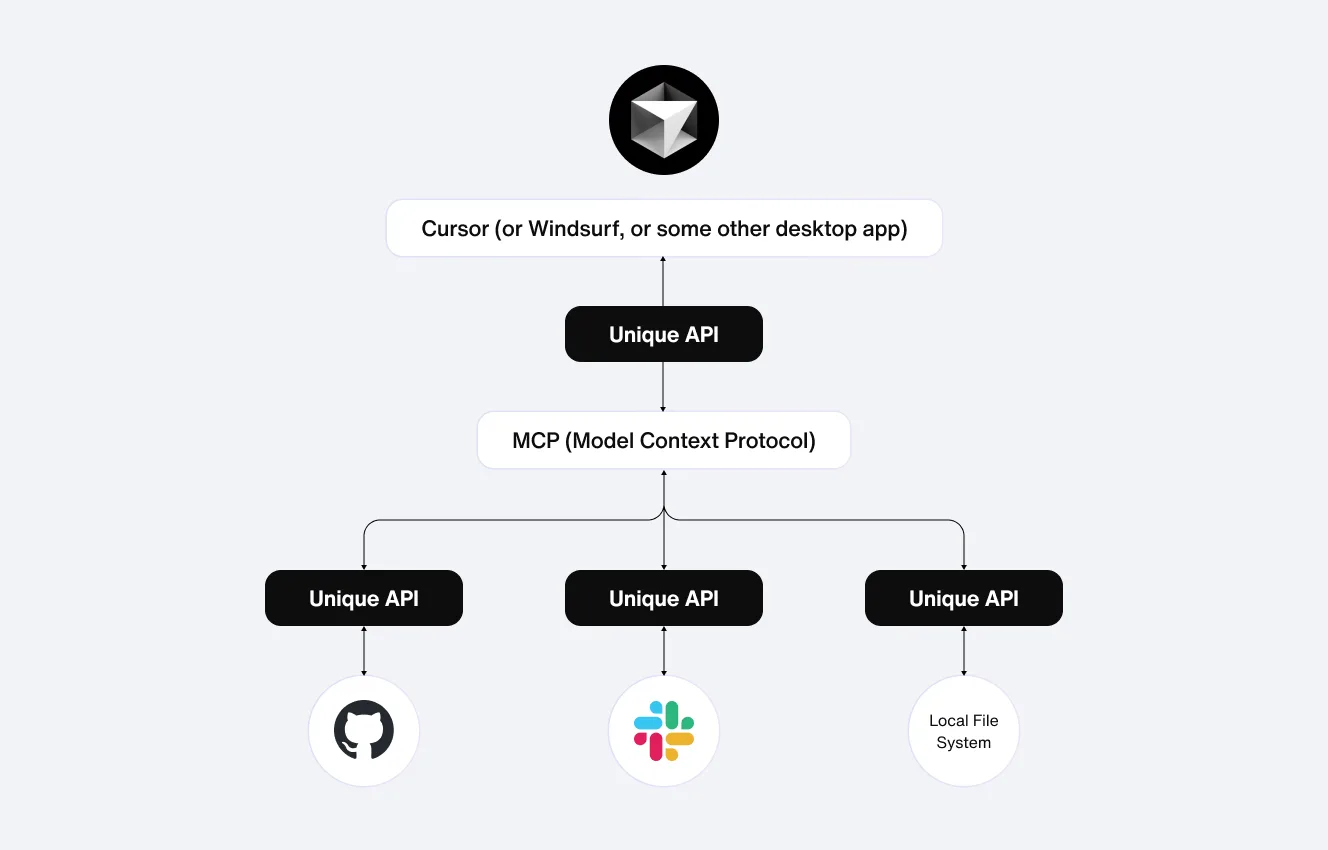AI agent APIs: The bridge between autonomous intelligence and action

AI agents—autonomous systems that perceive, decide, and act to achieve goals on behalf of users—represent a step change from previous automation. However, to operate effectively to their full potential, AI agents require access to real-time information from external sources, such as databases, web searches, and business applications.
This is where AI agent APIs come in.
For example, a retail AI agent could use APIs to check product inventory levels, update a CRM, and process returns in real time. Acting as the bridge between the agent’s reasoning engine and the real world, these APIs let agents pull in context, trigger workflows, and deliver personalized experiences.
However, many AI agents still struggle with limited or outdated access to data. Without these APIs, companies risk deploying agents that provide outdated information, break down, and frustrate customers because they're not production-ready.
In this article, we’ll explain what AI agent APIs are, how they power agentic systems, the challenges of agent API integration, and the trends shaping the future of AI-driven automation.

Sendbird awarded Best in Communications APIs
What is an AI agent API?
APIs (Application Programming Interfaces) are the building blocks that enable software systems to communicate, retrieve data, and trigger actions across platforms. AI agent APIs are a specialized type of API built for autonomous agents.
These APIs facilitate the creation, management, and operations of AI agents, allowing them to interact dynamically with other software and services—retrieving data, performing tasks, and coordinating workflows in pursuit of their defined goals. Without APIs, an AI agent could reason and make decisions but would remain isolated—unable to pull in outside information to inform their reasoning, then take accurate, meaningful action accordingly.
In short, AI agent APIs are vital to making AI agents operational in the real world—enabling them to reason, make decisions, and act based on live inputs in real-world environments.
For businesses, agent-ready APIs are crucial to building AI agent systems that can automate complex tasks, enhance customer experiences (CX) with live data and context, and integrate AI capabilities into existing applications and workflows.

Sendbird awarded Best in Communications APIs
How AI Agents turn APIs into actions
AI agent APIs let agents access external data and capabilities through structured requests, turning AI intelligence into real-world action. These APIs act as the execution layer that connects an agent’s reasoning engine to external systems and environments.
They enable AI agents to:
Access data dynamically across sources like its knowledge base, web searches, CRMs, or analytics.
Use tools and external services that enhance their functionality (function calling)
Trigger actions in real time, from scheduling a demo call for customers to updating a back-end system.
Learn and adapt by using feedback loops of those interactions to refine future behavior.
Unlike traditional software that calls APIs in a linear request–response pattern, agents operate at a higher level of abstraction. They use APIs as tools within their reasoning flow, deciding when and how to use them, planning, sequencing, and adapting API calls to achieve their broader goal (known as “chaining”).
Example scenario: Travel planning with traditional APIs vs. AI agent APIs
Say you’re searching for flights to Thailand on a travel booking site like Expedia. In a traditional flow, the booking site calls various airline reservation APIs, retrieves seat availability information, and displays the results. The process is linear—request in, response out.
But if you’re using Expedia’s AI agent for travel and hospitality, the agent-driven flow is very different. You might ask: “Help me plan a trip to Thailand next month,” and the agent uses APIs dynamically as part of its multi-step reasoning and action loop. This could involve:
Flight data: The agent calls multiple airline APIs to gather real-time flight availability and pricing.
Calendar integration: Through a Google Calendar API, it could see that you have a work commitment on a travel day and notify you to make adjustments.
AI suggestions: The agent retrieves hotel options and local experiences via a partner service API.
Itinerary delivery: The agent returns a curated set of options for an itinerary optimized to your unique needs and wants.
Rather than just fetching flight data, the agent orchestrates multiple APIs, reasons through trade-offs, and delivers a plan tailored to your unique needs. It's a core aspect of AI in travel.

Read the full report + in-depth CX case studies
The business benefits of AI agent APIs
The benefits of AI agent APIs include new levels of automation, business intelligence, and customer experience by enabling agents to access new capabilities and take actions across siloed systems. These advantages offer operational and strategic value for enterprises, including:
Efficiency at scale: By automating multi-step workflows across systems, agent APIs reduce manual effort and human errors, allowing businesses to operate more efficiently at scale. For example, an agent could process customer support tickets from end-to-end.
Reduced costs: Agent APIs connect new AI functionality to existing systems without costly, custom integrations, which helps businesses reduce staffing costs and human errors.
Live decisions & insights: APIs provide real-time connectivity for agentic ecosystems, enabling agents to act on live user data or push processed insights to analytics platforms for more timely, accurate business decisions.
Personalization: Agents use APIs to pull real-time data from backend systems, allowing them to tailor interactions based on customer preferences and history, delivering more relevant experiences that boost engagement and satisfaction at scale.
Customization & flexibility: The modular nature of APIs allows enterprises to customize and connect agents to the specific systems required for their unique needs, increasing the flexibility of AI workflow design.
Learning & adaptation: Through feedback loops enabled by APIs, agents collect data from customer interactions and other environmental factors to continuously improve performance and efficiency over time.
Resilient & adaptive systems: Robust and well-documented APIs provide the consistent, real-time connectivity agents need to be accurate, resilient, and responsible in dynamic business environments.

How much will you save with AI agents?
7 key challenges of AI agent APIs for businesses
While AI agent APIs offer major advantages, they also present challenges from data and technical issues to operational complexities. Understanding these obstacles is crucial for successful implementation. Here are some of the most common challenges:
API limitations and reliability: AI agents are only as effective as their API integrations. Performance and user trust can be eroded by API failures, outdated endpoints, and latency issues, especially without robust, enterprise-grade APIs.
Adaptive rate limiting: Traditional rate-limiting fails to account for the "bursty," high-volume call patterns of AI agents. Without adaptive strategies, legitimate activity can be mistaken for cyberattacks, blocking important workflows.
Legacy system integrations: AI agents often need to interact with older enterprise systems, which can cause significant compatibility and interoperability issues without agent-ready APIs.
Scalability and performance bottlenecks: Managing multiple AI agent workflows across different APIs can strain computational resources and lead to performance bottlenecks as usage scales.
Data access and quality: Poor data quality, often resulting from siloed, incomplete, or "noisy" business data, can degrade agent performance. Agents need secure, permission-aware, high-quality data to reason and provide reliable outputs.
Unique security vulnerabilities: Autonomous agents introduce new security risks such as prompt injection, privilege escalation, and unauthorized data access. APIs must be protected with robust authentication, encryption, and threat detection.
AI governance and monitoring: Safely deploying AI agents at scale requires robust AI governance frameworks. These must include real-time observability, detailed audit trails, and anomaly detection to ensure compliance and reliable operation

Sendbird awarded Best in Communications APIs
7 trends shaping the future of AI agents and APIs
Gartner predicts that AI agents will be integrated into 33% of enterprise applications by 2028.
This shift is driving demand for enterprise-ready APIs that support dynamic orchestration. Several key trends are shaping this future, requiring a new approach to software development:
Standardized integration protocols: Emerging standards like Model Context Protocol (MCP) streamline how agents access tools and data sources. This framework standardizes how context is shared, improving interoperability and making agent development more efficient.

Composable agents as APIs: Expect modular ecosystem where agents are exposed as APIs, allowing specialized agents to collaborate agent-to-agent (A2A). This enables multi-agent systems to solve complex problems more effectively.
Event-driven architecture: Technologies are proliferating to enable real-time, low-latency communication between agents. This architectural shift ensures that agent systems can scale dynamically and react to events as they occur.
Multi-modal capabilities: Future APIs will support rich, human-like interactions across text, image, video, and voice AI. This capability is essential for advanced use cases in areas like AI customer service or agentic commerce.
API-first design strategy: As agentic ecosystems grow, an API-first approach ensures systems are secure, scalable, and ready for innovation. The best agent APIs will become intelligent interfaces with robust authorization and observability.
Agent-ready API design: API design is shifting to meet the needs of autonomous agents, requiring APIs to be machine-consumable, self-describing, and semantically rich. This evolution is crucial for unlocking the full potential of autonomous AI.
Ethical governance and security: With autonomous AI capabilities comes the need for robust governance. Future API design must integrate enhanced security, ethical safeguards, and comprehensive observability to ensure responsible agent deployment and interaction.

Sendbird awarded Best in Communications APIs
How Sendbird's AI agent APIs drive business transformation and growth
For over a decade, Sendbird has been a trusted provider of award-winning communication APIs. These are now part of our AI agent platform for omnichannel AI support and CX, including:
Safeguards API: Monitors AI agent content in real time to ensure compliance, security, and customer trust by preventing policy violations, hallucinations, and harmful outputs.
Integrations API: Seamlessly connects AI agents to the existing enterprise support stack, ensuring smooth human handoffs and data-unified workflows.
Omnichannel API: Our core communication APIs and SDKs extend the AI agent platform across chat, web, email, SMS, WhatsApp, and more for consistent, high-satisfaction CX at scale.
Data Export API: Extracts detailed conversation and performance data from agents' interactions for feeding to BI and analytics for decision-making and optimization.
Platform API: Delivers enterprise flexibility with server-side features and client SDKs to power scalable, tailored AI agent solutions.
Want to learn more about Sendbird’s unique combination of trusted agent-ready APIs, enterprise-grade infrastructure, and agentic AI?
👉 Contact sales or request a demo.











